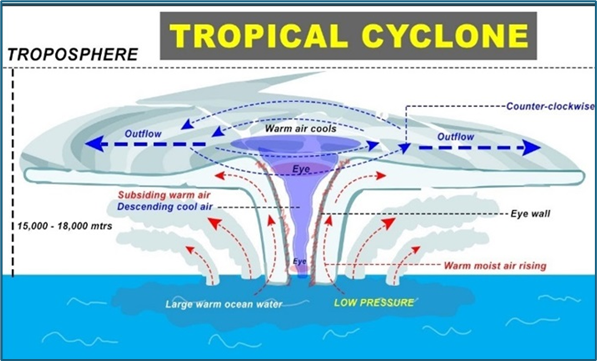Why in news?
Severe Cyclonic Storm Dana made landfall on the Odisha coast on the night of October 24. The storm made landfall at a speed of 100 to 110 kmph gusting at 120 kmph.
What’s in today’s article?
- Tropical Cyclone
- Naming of cyclone
- Landfall of cyclone
Tropical Cyclone
- About
- Cyclones that develop in the regions between the Tropics of Capricorn and Cancer are called tropical cyclones.
- The World Meteorological Organisation uses the term 'Tropical Cyclone’ to cover weather systems in which winds exceed ‘Gale Force’ (minimum of 34 knots or 63 kph).
- Tropical cyclones are the progeny of ocean and atmosphere, powered by the heat from the sea; and driven by easterly trades and temperate westerlies, high planetary winds and their own fierce energy.
- Formation of cyclones

- Tropical Cyclone is a weather phenomenon, which is formed only over warm ocean waters near the equator.
- Characteristics of a Tropical Cyclone:
- The centre of a cyclone is very calm and clear with very low air pressure. The average speed is 120 kmph.
- They have closed isobars which leads to greater velocity.
- Isobars are imaginary lines on a weather map that connect locations with equal atmospheric pressure.
- They develop over oceans and sea only.
- They move from east to west under the influence of trade winds.
- They are seasonal in nature.
- Classification of cyclones
- Cyclones are classified on the basis of wind speed by the Indian Meteorological Department (IMD):
- Depression: Wind speeds of between 31–49 km/h
- Deep Depression: Between 50-61 km/h
- Cyclonic Storm: Between 62–88 km/h
- Severe Cyclonic Storm: Between 89-117 Km/h
- Very Severe Cyclonic Storm: Between 118-166 Km/h
- Extremely Severe Cyclonic Storm: Between 167-221 Km/h
- Super Cyclonic Storm: Above 222 Km/h
- Category of a tropical cyclone
- The category of a tropical cyclone is determined by its sustained wind speed, as measured by the Saffir-Simpson Hurricane Wind Scale.
- It is classified into five categories — Category 1 to Category 5.
- While Category 1 tropical cyclones bring winds of 119 to 153 kmph, Category 5 tropical cyclones, which are the strongest, have winds of 252 kmph or higher.
- Storms that reach Category 3 and higher are considered major tropical cyclones due to their potential to inflict significant damage.
- Tropical cyclones are known by different names in various regions
- Hurricanes – In the in the West Indian islands in the Caribbean Sea and Atlantic Ocean.
- Tornados - In the Guinea lands of West Africa and southern USA
- Typhoons – In the Northwest Pacific Ocean, particularly affecting East and Southeast Asia (e.g., Japan, Philippines, China, Taiwan).
- Cyclones – In the Southwest Indian Ocean (off the coast of Africa, Madagascar), the Southeast Indian Ocean, and the Southwest Pacific Ocean.
- Willy-Willies – An informal term used for tropical cyclones in Australia.
Naming of Cyclones
- Cyclone Dana
- The name Dana was suggested by Qatar to the World Meteorological Organisation/United Nations Economic and Social Commission for Asia and the Pacific (WMO/ESCAP).
- Process of naming
- Worldwide, there are six regional specialised meteorological centres (RSMCs) and five regional Tropical Cyclone Warning Centres (TCWCs) mandated for issuing advisories and naming of tropical cyclones.
- The five regional Tropical Cyclone Warning Centres (TCWCs) are:
- ESCAP/WMO Typhoon Committee,
- WMO/ESCAP Panel on Tropical Cyclones
- It is responsible for naming of cyclones in the Indian Ocean.
- RA(Regional Association) I Tropical Cyclone Committee,
- RA IV Hurricane Committee,
- RA V Tropical Cyclone Committee.
- IMD is one of the six RSMCs to provide tropical cyclone and storm surge advisories to under the WMO/Economic and Social Commission for Asia-Pacific (ESCAP).
- WMO/ ESCAP is an inter-governmental regional body jointly established by the World Meteorological Organization (WMO) and the United Nations Economic and Social Commission for Asia-Pacific (ESCAP) in 1972.
- Members – It has 13 countries as its members.
- Bangladesh, India, Iran, Maldives, Myanmar, Oman, Pakistan, Qatar, Saudi Arabia, Sri Lanka, Thailand, United Arab Emirates and Yemen.
- They contribute to a set of names which are assigned sequentially whenever a cyclonic storm develops.
- The list of 169 cyclone names released by IMD in 2020 was provided by these countries — 13 suggestions from each of the 13 countries.
- So, the tropical cyclones forming over different Ocean basins are named by the concerned RSMCs & TCWCs.
What is landfall of a cyclone?
- Landfall is the event of a tropical cyclone coming onto land after being over water.
- As per the IMD, a tropical cyclone is said to have made a landfall when the center of the storm – or its eye – moves over the coast.
- The "eye" of a cyclone is a region of relatively calm weather found at the center of the storm.
- Within the eye, winds are light and variable, often with clear or only partially cloudy skies.
- The size of the eye can vary significantly, ranging from a few kilometers to over 50 kilometers (30 miles) in diameter in larger cyclones.
- During landfall, the outer bands of the storm may have already reached the coast, bringing strong winds, heavy rain, and storm surge.
- Landfall marks the moment when the cyclone officially reaches the land.
- A landfall should not be confused with a ‘direct hit’, which refers to a situation where the core of high winds (or eyewall) comes onshore but the centre of the storm may stay remain offshore.










